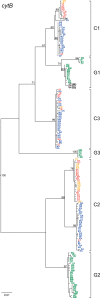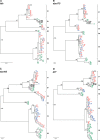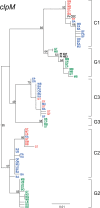Multigenomic Delineation of Plasmodium Species of the Laverania Subgenus Infecting Wild-Living Chimpanzees and Gorillas
- PMID: 27289102
- PMCID: PMC4943199
- DOI: 10.1093/gbe/evw128
Multigenomic Delineation of Plasmodium Species of the Laverania Subgenus Infecting Wild-Living Chimpanzees and Gorillas
Abstract
Plasmodium falciparum, the major cause of malaria morbidity and mortality worldwide, is only distantly related to other human malaria parasites and has thus been placed in a separate subgenus, termed Laverania Parasites morphologically similar to P. falciparum have been identified in African apes, but only one other Laverania species, Plasmodium reichenowi from chimpanzees, has been formally described. Although recent studies have pointed to the existence of additional Laverania species, their precise number and host associations remain uncertain, primarily because of limited sampling and a paucity of parasite sequences other than from mitochondrial DNA. To address this, we used limiting dilution polymerase chain reaction to amplify additional parasite sequences from a large number of chimpanzee and gorilla blood and fecal samples collected at two sanctuaries and 30 field sites across equatorial Africa. Phylogenetic analyses of more than 2,000 new sequences derived from the mitochondrial, nuclear, and apicoplast genomes revealed six divergent and well-supported clades within the Laverania parasite group. Although two of these clades exhibited deep subdivisions in phylogenies estimated from organelle gene sequences, these sublineages were geographically defined and not present in trees from four unlinked nuclear loci. This greatly expanded sequence data set thus confirms six, and not seven or more, ape Laverania species, of which P. reichenowi, Plasmodium gaboni, and Plasmodium billcollinsi only infect chimpanzees, whereas Plasmodium praefalciparum, Plasmodium adleri, and Pladmodium blacklocki only infect gorillas. The new sequence data also confirm the P. praefalciparum origin of human P. falciparum.
Keywords: Laverania; P. falciparum; Plasmodium parasites infecting chimpanzees and gorillas; cryptic Plasmodium species; single genome sequencing.
© The Author(s) 2016. Published by Oxford University Press on behalf of the Society for Molecular Biology and Evolution.
Figures




References
-
- Abkallo HM, et al. 2014. DNA from pre-erythrocytic stage malaria parasites is detectable by PCR in the faeces and blood of hosts. Int J Parasitol. 44:467–473. - PubMed
-
- Adler S. 1923. Malaria in chimpanzees in Sierra Leone. Ann Trop Med Parasit. 17:13–18.
-
- Anthony TG, Polley SD, Vogler AP, Conway DJ. 2007. Evidence of non-neutral polymorphism in Plasmodium falciparum gamete surface protein genes Pfs47 and Pfs48/45. Mol Biochem Parasitol. 156:117–123. - PubMed
-
- Blacklock B, Adler S. 1922. A parasite resembling Plasmodium falciparum in a chimpanzee. Ann Trop Med Parasitol. XVI:99–107.
Publication types
MeSH terms
Substances
Grants and funding
LinkOut - more resources
Full Text Sources
Other Literature Sources
Research Materials
Miscellaneous

